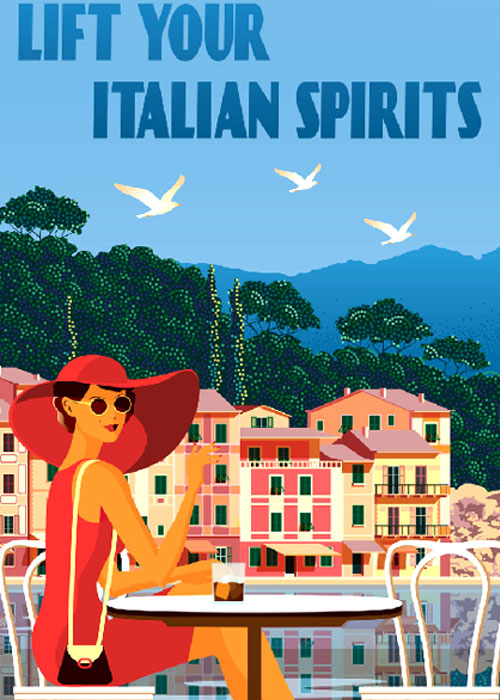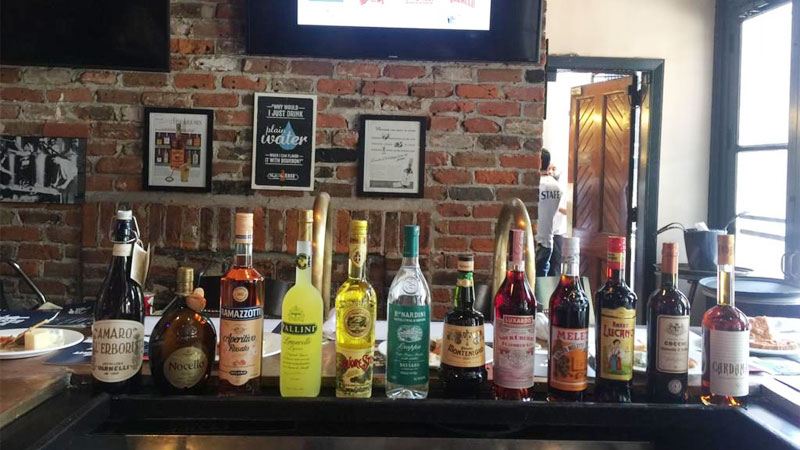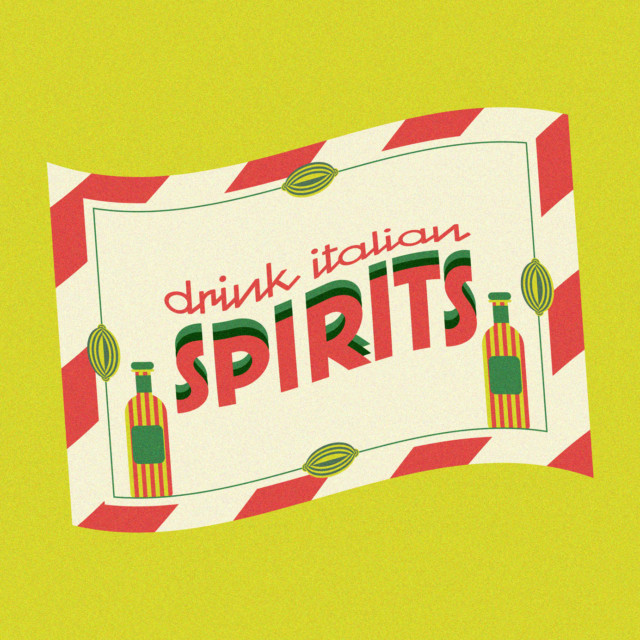As Kate McKinnon awkwardly put it in a recent “Saturday Night Live” skit on the strangeness of post-pandemic socializing, after a year of home cooking and home drinking, it can feel weird to start “going to dinner again.” Americans rediscovering life outside the home might notice something else that is just a bit unusual: Beyond the popular amaro and vermouth they remember from the Before Times, they’re likely to come across even more Italian spirits brands when they start visiting bars and restaurants again in 2021, thanks to an official Italian government program that hopes to use American bartenders and servers to reawaken interest in Italy’s booze.
Called the Spirits Promotion Project, the Italian Trade Agency has partnered with an array of its alcohol producers for a program that originally started during the pandemic, with a continuation and expansion this year. While brands like Aperol and Fernet-Branca that originally launched the project are fairly well known, many of this year’s newer participants are a bit more obscure: Pallini Peachcello, Meletti Anisette, Varnelli Amaro, and Amaro Dell’Etna among them. Those less obvious brands, though foreign to most American drinkers, are typical of the “small distilleries run by single families for more than a century,” Dr. Antonino Laspina, Italian trade commissioner, tells VinePair.

Making Up Losses
In part, the program is an attempt to make up for the lack of tourists traveling to Italy during the pandemic. As one of the European Union’s hardest-hit countries, Italy’s losses in terms of travel and tourism for 2020 amounted to about $144 billion, according to a recent report from the World Travel and Tourism Council.
To put it another way: If Americans have been unable to go to Italy to sample the country’s various drinks in person, they can at least try a wider array of Italian spirits when they start going out again at home.
That can save time and trouble — and introduce drinkers to some rather unexpected flavors. At the Doctor’s Office in Seattle, Matthew Powell recalls that he had to discover the obscure amari on his bar’s list the hard way: by learning the Italian phrases for “What amari do you have?” and “Other than that one?” and repeating them over and over again on a tasting trip across Italy.
“I ended up trying a lot of different amari as a result, and got pretty far off the beaten path by the end of the trip,” Powell says. “I came to realize that a lot of these smaller producers made amari that had very different flavor profiles than the few that I was really familiar with. Some were really light and bright. Some were almost aperitivo. Some were really rich with baking-spice flavors.”
If seeing smaller brands in the program is somewhat unexpected, a government promoting its country’s booze in general is hardly unusual: The government of France promotes Champagne, Burgundy, and Bordeaux in its major export markets, just as the United Kingdom promotes Scotch and British gin. The U.S. State Department uses craft beer, California wine, bourbon, and other high-profile American products as ersatz ambassadors for the country overseas.
But when it comes to cocktail-friendly bottles, Italy is a truly special case: It is hard, if not impossible, to think of another country with as diverse a collection of charismatic and extremely mixable alcohol products. While many other countries in Europe make digestive bitters, none of them have the popularity — and enjoy the love — of Italian amaro in the U.S. And amaro is hardly alone: For many drinkers, red vermouth is Italian vermouth, and you can’t really make a Manhattan, a Bronx Cocktail, or a Vieux Carré without something that has “rosso” in its name. For that matter, could the average American bar or bistro even function without a steady supply of Campari and Aperol?
For Powell, the products from Italy’s family-owned distilleries open up new possibilities for mixing, including new inspiration for low-octane drinks.
“They don’t have a huge, wide distribution, but they’re incredibly delicious,” Powell says. “It brings entirely different flavor profiles if you want to actually make them with cocktails, but I tend to just sip them on their own. If I want to drink low-ABV, one of my go-to choices will be an amaro with soda. Just get that, put it over ice, and lengthen it with soda. If someone does want to make something that’s on the lower-alcohol side, that really provides a lot of opportunity as well.”
With all those various distillates, fortified wines, liqueurs, and cordials in mind, it might start to seem like Italy has an unfair advantage in terms of mixable beverages, ranging from nocino to grappa. Part of that simply comes down to the country’s geography and culture, says Tad Carducci, director of outreach and engagement for Gruppo Montenegro, maker of the celebrated amaro and one of the program’s current partners.
“Italy is the land of abundant sunshine, verdant green hills, and incredible agriculture, so it’s no wonder that they have the perfect raw materials for amazingly flavorful spirits,” Carducci says. “Not coincidentally, Italians are masterful at knowing how to eat and what drinks to consume, either before, during, or after a meal.”

Using the Bartender
As part of the program, the Italian Trade Organization has produced a consumer-friendly guide to Italian spirits, as well as a book of recipes. A major component, however, is the cocktail trade, with industry-specific educational seminars that aim to enlist bartenders in pushing Italian spirits. Those events kicked off Wednesday, June 30, with a virtual seminar hosted by cocktail specialist Mimi Burnham that on working with amaro, vermouth, grappa, limoncello, and other products. Forthcoming events will be held in conjunction with the United States Bartenders’ Guild, Bar Convent Brooklyn, and Tales of the Cocktail.
Those industry connections will help drinks-industry workers build familiarity with Italian spirit categories, production processes, and lesser-known producers, Laspina says.
“Bartenders are a key gatekeeper audience for this program,” Laspina says. “They are often the final reference point for consumers trying new spirits and cocktails, and have the ability to generate awareness.”
For Carducci, bar hands are on “the front lines” of consumer education.
“There is no more attentive student of spirits than one seated in front of a knowledgeable and passionate bartender,” Carducci says. “When stories are shared, production processes explained, and, ultimately, a spirit is tasted either neat or in cocktails, those consumers remember the zeal with which the bartender presented the information.”
In addition to explanations and conversations about the spirits, Haley Forest, a brand ambassador for program participant Italicus Rosolio di Bergamotto, says that bartenders’ ability to generate awareness also has to do with smaller portions and a lower cost to entry.
“Most people would be cautious to try a new spirit they’ve never heard of by buying a full bottle off the shelf,” Forest says. “Seeing an unusual ingredient in a cocktail is an easy invitation to try something new. When a bartender creates something using these lesser-known spirits, it’s because it is the missing piece that makes the drink complete.”
Though the program partly aims to make up for travel and tourism losses due to the pandemic, its inspiration goes beyond Covid-19. A recent trade war between the U.S., the U.K., and the EU deeply affected Italian alcohol exports, Laspina says, though those mutual tariffs have thankfully since been suspended by all sides.
“Over the past year, our efforts strengthened as the liqueurs and cordials categories were hit by a 25 percent tariff on value. Our exports suffered greatly, with a 40 percent loss in value and 21.5 percent [loss] in quantity,” Laspina says. “This brought Italy from $178 million in exports and the eighth position as a global supplier to $107 million and the ninth position.”
That setback might be enough reason to consider supporting Italian spirits whenever you start going out again, especially those that are produced by small, family-owned producers.
And who knows? With enough of them, maybe going out for drinks will no longer feel weird.
This story is a part of VP Pro, our free platform and newsletter for drinks industry professionals, covering wine, beer, liquor, and beyond. Sign up for VP Pro now!
